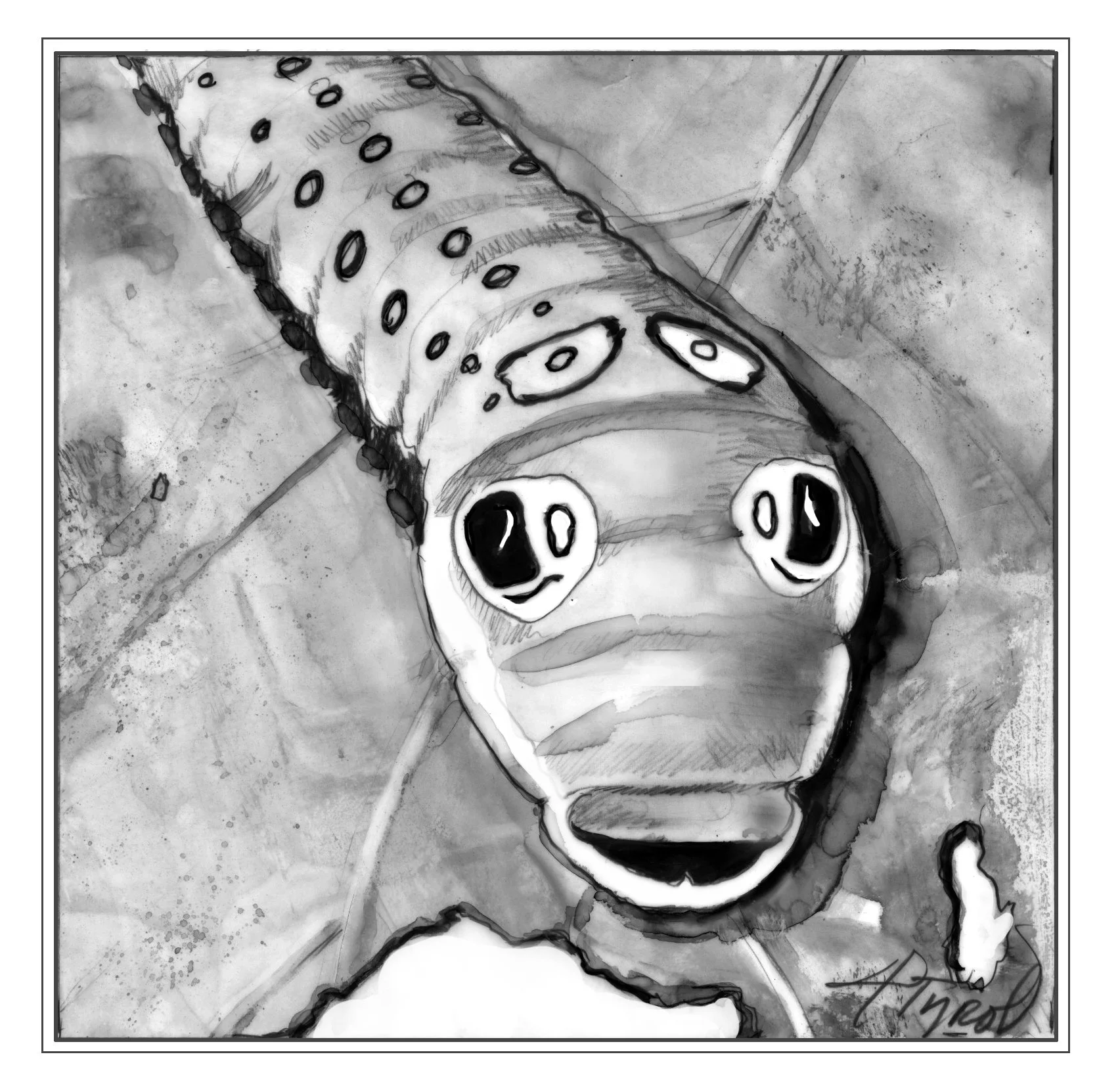The Outside Story: Spicebush swallowtails rely on beautiful design
August 1, 2023 | By Colby GalliherIllustration by Adelaide Murphy Tyrol
At first, I suspected it was the deer that had almost completely defoliated the northern spicebush sapling I had planted just weeks earlier. Only days prior, it had been brimming with new growth, and now all that remained were two leaves wrapped into cigarlike cylinders.
Curious, I inspected this pair of surviving leaves. At the opening of each, snug between the leaf edges, was a bulbous green head adorned with a set of black, cartoonish eye spots. I had found my perpetrator, and it wasn’t the deer; it was the caterpillars of the spicebush swallowtail.
The spicebush swallowtail (Papilio troilus) is one of several butterflies in the Papilionidae family, whose range extends into the Northeast. The name is a nod to one of this butterfly’s preferred host plants, although spicebush swallowtails count multiple species in the laurel family among their caterpillar hosts.
The adult butterflies will visit a range of both native and non-native flowers for nectaring. Their wide array of host plants and food sources means that spicebush swallowtails may occur from forests and swamps to roadsides and backyards, although they’re especially likely to be found in moist woodlands and at the margins of fields.
Against these green summer backdrops, spicebush swallowtails cut a striking profile. As do their Papilionidae relatives, the butterflies sport ethereal dustings of cobalt and a row of pale blue, circular markings along the margins of their jet black forewings and hindwings. One similarity to another swallowtail species acts as a defensive advantage: female spicebush swallowtails, whose coloring slightly differs from males, resemble the poisonous pipevine swallowtail (Battus philenor), which helps to deter would-be predators. Bluish-green spots along the base of their dorsal hindwings distinguish spicebush swallowtails from their relatives.
Also similar to other swallowtail species, the spicebush swallowtail caterpillar employs several defensive tactics to avoid predation. The first two larval instars (stages) look like bird droppings. Later instars, with their bright green and yellow coloration and two black eyes on a bulging head, mimic a green snake (or, some say, a green frog). At this stage in their lifecycle, the caterpillars turn into daytime recluses.
Exhibiting a remarkable feat of engineering, they affix a bed of silk to a chosen leaf. When the silk dries, the tension folds the leaf edges into a shelter – like the two I found on my denuded spicebush – to which the caterpillars retreat until emerging at night to feed. When threatened, the caterpillars can also deploy special organs, called osmeteria, to form a phalanx of bright orange horns.
The spicebush swallowtail’s range extends from the southern United States to New England and southern Canada. Although historically limited by northern New England’s climate, sighting records from iNaturalist indicate the swallowtail and its eponymous shrub now reach into central and northern New Hampshire and Vermont.
Spicebush swallowtail populations are secure, but laurel wilt disease poses a threat to their abundance. Discovered near Savannah, Georgia, in 2002, laurel wilt is caused by a fungus transmitted by the red bay ambrosia beetle, and has already devastated red bay, an important spicebush swallowtail host plant in the Southeast. The disease may eventually affect spicebush and sassafras, this swallowtail’s primary northern hosts, if warmer winters facilitate the ambrosia beetle’s spread into the Northeast.
In my own yard, upon cracking the mystery of the naked spicebush, I fretted. Unable to tell how far along the two leaf-munching caterpillars were, I wondered where they would find their next meal. A grisly turn of events soon made that question irrelevant; the following morning, I opened my back door to check on the caterpillars and saw a gray catbird fluttering around the nude sapling. A quick inspection revealed the leafy hammocks robbed of their tenants.
While these two caterpillars met their end last year before their metamorphosis into handsome swallowtails, the cycle began anew this spring. The spicebush endured its trauma and threw new growth, buoyed by my addition of another, fuller sapling in the same area. And earlier this summer, I discovered a series of cloudy-white, spherical eggs spread across several leaves of the new spicebush and its older counterpart.
The shrubs may not welcome the coming caterpillars (while the catbirds flap for joy), but I hope to see a crop of spicebush swallowtails rising from the late-summer garden.
Colby Galliher is a writer and analyst who calls the woods, meadows, and rivers of New England home. The Outside Story is assigned and edited by Northern Woodlands magazine and sponsored by the Wellborn Ecology Fund of the New Hampshire Charitable Foundation.

